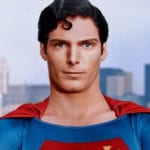 Creepy
Creepy  Creepy
Creepy  Technology
Technology 10 Scientific Breakthroughs of 2025 That’ll Change Everything
 Our World
Our World 10 Ways Icelandic Culture Makes Other Countries Look Boring
 Misconceptions
Misconceptions 10 Common Misconceptions About the Victorian Era
 Mysteries
Mysteries 10 Strange Unexplained Mysteries of 2025
 Miscellaneous
Miscellaneous 10 of History’s Most Bell-Ringing Finishing Moves
 History
History 10 Great Escapes That Ended Right Back in Captivity
 Weird Stuff
Weird Stuff 10 Fascinating Things You Might Not Know About Spiders
 Food
Food 10 Everyday Foods You Didn’t Know Were Invented by the U.S. Military
 History
History 10 Odd Things Colonial Americans Kept at Home
 Creepy
Creepy 10 More Representations of Death from Myth, Legend, and Folktale
 Technology
Technology 10 Scientific Breakthroughs of 2025 That’ll Change Everything
 Our World
Our World 10 Ways Icelandic Culture Makes Other Countries Look Boring
Who's Behind Listverse?

Jamie Frater
Head Editor
Jamie founded Listverse due to an insatiable desire to share fascinating, obscure, and bizarre facts. He has been a guest speaker on numerous national radio and television stations and is a five time published author.
More About Us Misconceptions
Misconceptions 10 Common Misconceptions About the Victorian Era
 Mysteries
Mysteries 10 Strange Unexplained Mysteries of 2025
 Miscellaneous
Miscellaneous 10 of History’s Most Bell-Ringing Finishing Moves
 History
History 10 Great Escapes That Ended Right Back in Captivity
 Weird Stuff
Weird Stuff 10 Fascinating Things You Might Not Know About Spiders
 Food
Food 10 Everyday Foods You Didn’t Know Were Invented by the U.S. Military
 History
History 10 Odd Things Colonial Americans Kept at Home
10 Ways The ‘Jurassic Park’ Franchise Got It Wrong
With Jurassic World: Fallen Kingdom now in theaters, dino-mania is running rampant once again. However, for true dinosaur lovers, there are many mistakes in the Jurassic movies. Specifically, how the dinosaurs changed from the earlier versions.
Other scientific impossibilities also make an appearance in these films. Despite how much fun it is to suspend disbelief and lose yourself in the world of Jurassic Park, let’s come back to reality for a few minutes and look into some of the more advanced mistakes made in this movie franchise.
Spoiler Alert: If you haven’t seen the Jurassic Park films, proceed with caution. We do reveal a fair amount about the movies.
10 DNA Extraction

The idea of extracting fossilized DNA in an attempt to recreate or clone a dinosaur does not sound that far-fetched considering that animal cloning has been done already. Remember Dolly the sheep? So, in theory (mixed with make-believe and a dash of cinema magic), we see this scenario come to life. But could it really be done?
No, it could not.
First of all, to clone something is to make an exact genetic copy. This starts at the smallest level of molecular biology—one gene, one DNA strand at a time. According to an article published by NBC News, Murdoch University researcher Mike Bunce stated, “All DNA would be completely destroyed in bone after about 6.8 million years.”[1]
The Jurassic Period was 201 to 145 million years ago. So, the DNA extraction process portrayed in the movie is awesome but totally unfounded. There is no data whatsoever to support it.
Furthermore, a report by a team of scientists and amber specialist Dr. David Penney has established that the method of DNA removal used in the movie is “likely to be impossible and will have to remain in the realm of fiction.”
9 Brachiosaurus Takes A Stance
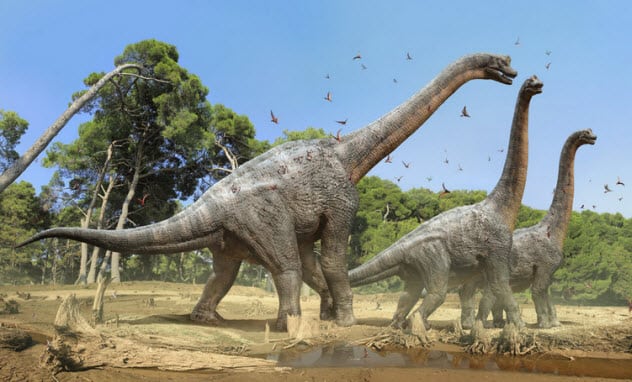
In the first movie, Jurassic Park, we see the Brachiosaurus, a plant-eating sauropod, stand on its hind legs to reach up and retrieve leaves to eat. This majestic dinosaur takes the same stance in the most recent film, Jurassic World: Fallen Kingdom, but under much different circumstances.
On first viewing, this does not raise too much concern. These dinosaurs are herbivores reported to be about 7 meters (23 ft) tall and 26 meters (85 ft) long.[2] It’s plausible that they need to stretch to get some of those leaves even with their long necks.
We’ve all see our cats or dogs take a similar stance when they want something just out of reach, so why not a dinosaur?
Think of the proportional ratio, though. How much does a Brachiosaurus weigh? Where does it carry most of its weight? Even with its tail for additional support, could those two legs hold up such a massive creature?
It’s not like these dinosaurs could lean on the tree for support. They are reported to have weighed 33–88 tons. Wouldn’t the tree just come crashing down? If that is the case, then why do they not topple trees as a norm when feeding?
Even when compared with other dinosaurs that walk upright on two legs, it is not feasible. Bipedal dinosaurs have massive, muscular hind legs and lighter, smaller, sleeker torsos. The beautiful Brachiosaurus does not.
8 Jurassic Period
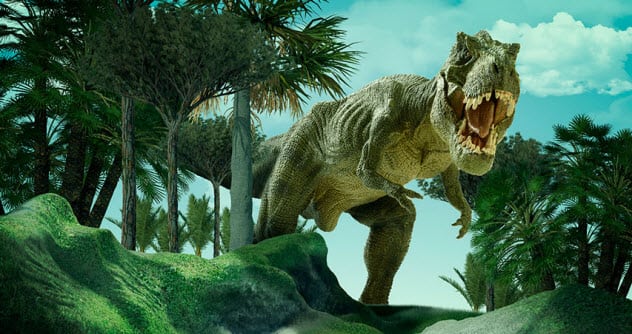
Although this has been debated recently, one of the biggest mistakes by this franchise occurred when they placed the Tyrannosaurus rex in the Jurassic Period—or maybe it was when they named the movie. Perhaps it should have been called Cretaceous Park for a time period that took place about 66–68 million years ago.
During this period, the T. rex, Triceratops, Velociraptor, and Spinosaurus roamed the Earth. During the Jurassic Period, the dino population included the Plesiosaurus, Brachiosaurus, Stegosaurus, and Diplodocus—but not the tyrannosaurs.
Smithsonianmag.com really puts the oops into perspective with the following statement: “Less time separates us from Tyrannosaurus rex than separated T. rex from Stegosaurus.”[3]
But what are the Jurassic films without the T. rex? This is definitely a mistake worth forgiving. Or maybe it has nothing to do with the time periods. Due to DNA movie magic, perhaps the dinosaurs from all periods are allowed to coexist with one another and the human race.
7 The Mighty Spinosaurus
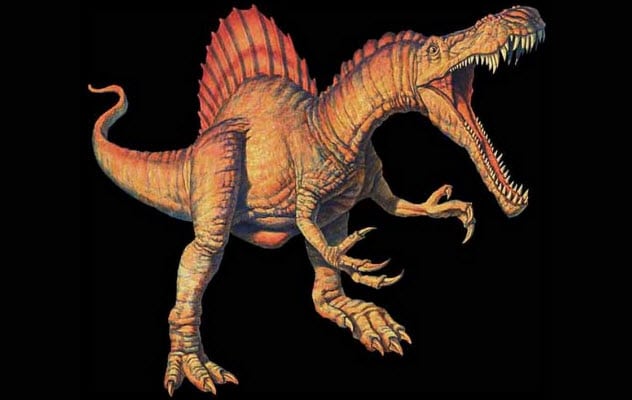
In the third Jurassic Park film, it is not the T. rex that saves the day as in the first Jurassic World film. At the end of Jurassic Park III, a T. rex and a Spinosaurus have an epic battle.
The Spinosaurus (also from the Cretaceous Period) thrived in an aquatic environment. His nose was fashioned much like the crocodiles of today and allowed for easy breathing. He also had sharp teeth for catching fish and a 2-meter-long (7 ft) spine to cut through the water at a phenomenal speed.
However, here’s the problem with that scenario. The Spinosaurus, which was the largest dinosaur and probably the first water dinosaur, was built like the aquatic animals of today with webbed feet and dense bones. These features were ideal for his life in the water but very unlikely to stand up to the brute force of T. rex.
Paleontologists estimate that the T. rex had a bite force of about 5,800 kilograms (12,800 lb), which makes him the “hardest-biting terrestrial animal” ever.[4] The hardest-biting aquatic animal is the megalodon, with a bite force of 18,600 kilograms (41,000 lb).
So Spiny was definitely the underdog in this fight.
6 Sense Of Smell
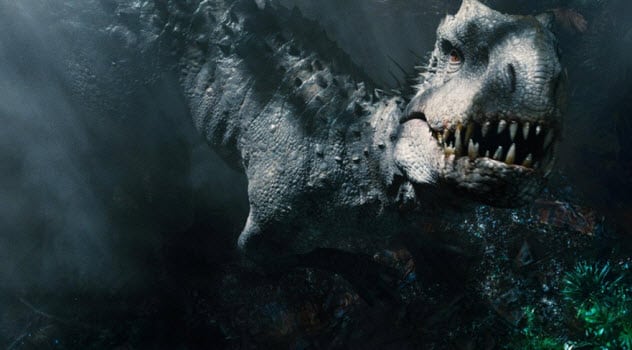
Remember the scene where Dr. Grant says, “Nobody move a muscle,” and they all freeze in place? This implies that the T. rex cannot see us if we are not moving—or that it has motion-based vision. This scenario actually plays out in a later scene as Grant exits the Land Rover when the tour of the park malfunctions.
It seems as if he has given up and is just standing there waiting for the dinosaurs to eat him. But he quickly realizes that the T. rex cannot see him. Later, we see Grant (and in other Jurassic movies, Claire) use flares to attract the attention of the T. rex while moving about feverishly.
However, the T. rex would undoubtedly rely on other senses to hunt. So simply being unable to see his prey would not result in him just walking away. What about his sense of hearing? The T. rex has Grant cornered. Sure, he isn’t moving. But the dinosaurs can hear his breathing or even his heart beating hard and fast, not to mention other bodily functions.
Fine, maybe Grant is right. The T. rex can’t see him. Obviously, the creature didn’t hear him. How about smell him? Animals have a keen sense of smell. Especially those that hunt live prey. After all, they have to begin somewhere and picking up an animal’s scent is often a starting place.
In Jurassic World, Owen douses himself with gasoline to mask his smell when he is hiding from the Indominus rex, a fictionally designed and created dinosaur. This supports the idea that predatory dinosaurs relied on their sense of smell.[5]
5 Size Does Matter
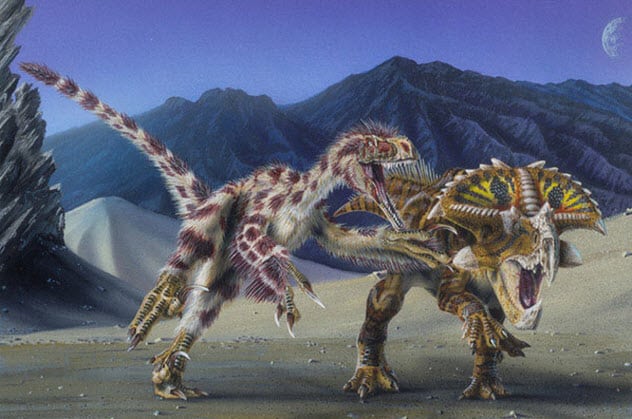
Velociraptors lived in the Late Cretaceous Period. Scientists describe them as “birdlike,” complete with a wishbone. However, the film made at least one huge error when it comes to Blue and her pack. Filmmakers grossly overexaggerated how big these fierce creatures were. Paleontologists compare the size of the Velociraptors to that of modern-day turkeys.
Furthermore, recent archaeological discoveries suggest that Velociraptors had feathers and perhaps wings but could not fly. Although they were not the man-sized creatures portrayed in the movies, they were swift and probably more like scavengers than hunters. Nevertheless, they did have the infamous long claw on their hind feet that we see click on ground as they hunt their prey.[6]
It is also important to note that these types of dinosaurs are referred to as simply “raptors” in the later movies.
4 Mosquitoes
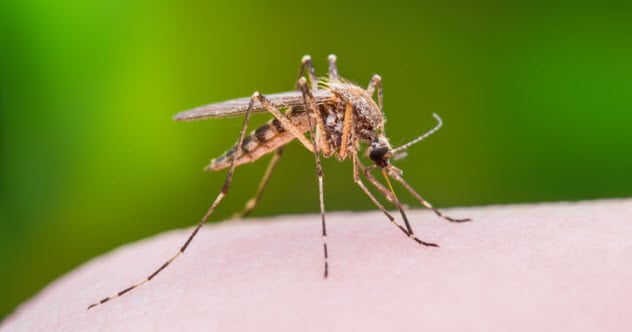
Take a hard look at the mosquito trapped in the amber of Dr. Hammond’s cane. A well-preserved specimen indeed. If you look closely, you can see the antennae and what appear to be hairs on them. These hairs are called flagella. Only on the male mosquito are the flagella visible to the naked human eye.
Okay, Hammond’s cane contains a male mosquito. However, according to pest control company Terminix, only female mosquitoes bite.[7] They require the nutrients in blood to be able to successfully lay their eggs. Consequently, only female mosquitoes would contain DNA of another animal. So, unless Hammond was able to harvest female mosquitoes, their depiction in the movie is inaccurate.
3 Frog DNA
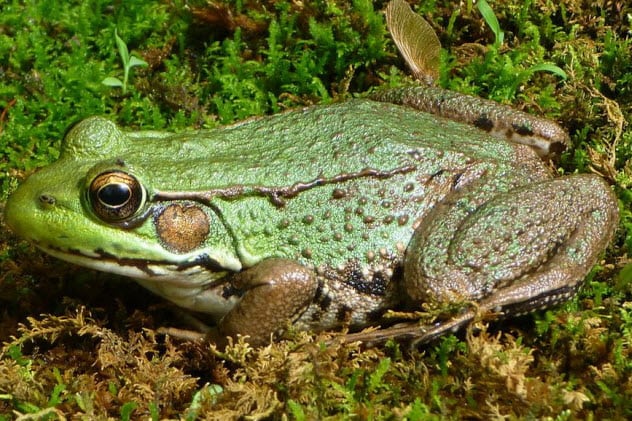
If you recall, scientists used frog DNA in Jurassic Park to fill in the missing genes from the DNA sequence extracted from the mosquitoes. This plays a significant role in the film because it is how the dinosaurs, which were all supposed to be female, were able to reproduce. Remember Dr. Grant explaining that some West African frogs can spontaneously change sex when there aren’t enough of the opposite sex to reproduce?
Did you know that frog DNA is more closely related to human DNA than it is to dinosaur DNA?
In an article coauthored by scientist Uffe Hellsten, he explained that DNA from amphibians and mammals contains several “chromosomes having genes arranged in the same order.” In fact, frogs share some of the same diseases as humans, such as cancer, asthma, and heart disease.[8]
On the other hand, dinosaur DNA is more closely related to that of birds. The Institute of Vertebrate Paleontology and Paleoanthropology is well on its way to proving that birds are the descendants of dinosaurs.
2 Venomous Dinosaurs
In the first Jurassic film, computer programmer Dennis Nedry (played by Wayne Knight) is sprayed with what appears to be venomous saliva from a Dilophosaurus as he is making his escape with stolen dinosaur embryos.
In real life, Dilophosaurus did not spit venom or have ear frills as depicted in Jurassic Park. Dilophosaurus was also considerably larger than shown in the movie. Jurassic Park depicted these dinosaurs as about the size of dogs, but they were actually 6 meters (20 ft) long and could weigh over 450 kilograms (1,000 lb). However, they only stood as tall as the average human being.
In an article published by Scientific American, curator Scott D. Sampson claims that there is no significant evidence to support that venomous dinosaurs actually existed.[9]
1 Dinosaurs’ IQs
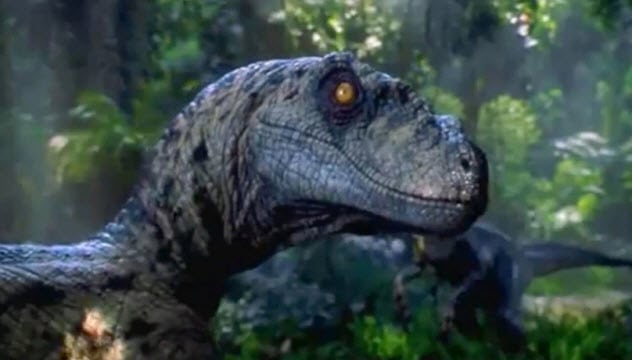
Okay, we have to agree that those raptors are intellectual dinosaurs. They can learn and follow commands. They show empathy and compassion. Well, Blue does by switching sides twice and protecting Owen, Claire, and the boys from the Indominus rex.
She works with the other raptors and is the Beta of the pack. She even appears to ask Owen if she can eat Claire. When he shakes his head, Blue obeys. Without giving away too much from Fallen Kingdom, Blue once again communicates with Owen when he solely speaks to her. She’s one smart cookie, right?
Based on the brain size of dinosaurs in real life, it is believed that their intellectual capacity was somewhat small and that they were not as smart as most other animals.[10] Perhaps they were not even as intelligent as modern-day birds.
Read about more Jurassic Park–sized misconceptions about ancient life on 10 Misconceptions You Might Have About Ancient Life and Top 10 Dinosaurs That Aren’t What They Were.







